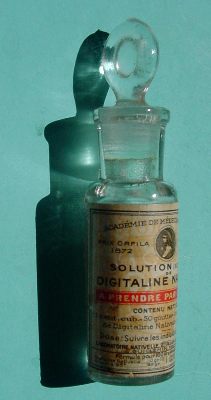Pharmazie |
||
Fläschchen mit DIGITALIN |
||
La digitoxine ou digitaline ou digitoxoside est un glycoside cardiotonique extrait de la digitale pourpre (Digitalis purpurea) et de la digitale laineuse (Digitalis lanata). Elle a été découverte par William Withering, un médecin et botaniste britannique. L'utilisation thérapeutique moderne de cette molécule sera rendue possible grâce aux travaux du pharmacien et chimiste français Claude-Adolphe Nativelle (1812-1889). Comme tous les glycosides cardiotoniques, elle est toxique. On l'utilise dans le traitement de diverses affections du cœur comme l'insuffisance cardiaque.
La digitaline cristallisée aurait pu figurer dans la pharmacopée de Hahnemann. Qui a découvert la digitaline cristallisée? NATIVELLE, pensons-nous. Nous connaissons tous la DIGITALINE NATIVELLE. Consultons le "DICTIONNAIRE UNIVERSEL DE MATIERE MEDICALE" de F.V Mérat et F.J. de Lens, daté de 1829. A la rubrique Digitaline, nous apprenons que cet alcaloïde a été découvert en 1824 par M. A. Leroyer, pharmacien à Genève et à la même époque par un monsieur Dulong d'Astafort, mais que c'est un certain monsieur Pauquy qui a la priorité de la découverte de la préparation de la digitaline cristallisée (thèse de Nicolle, 1824). De Nativelle, il n'est pas question à cette époque.
"Nativelle prepared digitaline cristallisée, which at last was believed to be pure. Meanwhile a commercial distinction had been established between German digitalin (originating from Walz's preparation), an amorphous powder easily soluble in water and alcohol, less soluble in chloroform, and very little soluble in ether; and French crystalline digitalin (that of Homolle and Quevenne, and Nativelle), easily soluble in chloroform and alcohol, but hardly soluble in water and ether. In this connection it may be stated that the French Codex gives detailed directions for the preparation of both digitaline amorphe and digitaline cristallisée, the yield of the latter being 1 gram from each kilogram of leaves. To Schmiedeberg (1874) we are indebted for a critical study of the more important digitalins of commerce. He arrived at the conclusion that these preparations were composed mainly of the following principles: Digitonin, digitoxin, digitalin, and digitalein. The first is an inactive glucosid, while the three others have the property of acting upon the heart, digitoxin possessing this power in a most pronounced degree. The more recent researches of Kiliani have materially extended our knowledge of the chemical nature of these substances.
Zur Person von Claude-Adolphe NATIVELLE (1812-1889) siehe auf Wikipedia: https://fr.wikipedia.org/wiki/Claude-Adolphe_Nativelle
|




